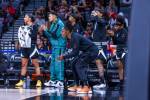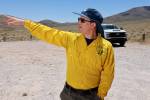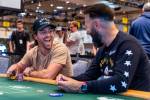BLADES OF COREY – Ice Creamed (Hockey player)





The loudest sound in recorded history was the 1883 eruption of Hawaii’s Krakatoa volcano (310 decibels).
The runner-up may be the sound of the 6-ounce frozen rubber disk that just whacked my wire face mask at 100 mph. I still will be hearing it as you read this.
This morning, I’m a practice goalie for the Wranglers at the Orleans Arena. Las Vegas’ minor league hockey team employs practice goalies whenever one of its two full-time goalies is lucky enough to be promoted to the American Hockey League — or a wacky newspaper reporter calls.
"Keep your chin down!" screams Nick Anderson after landing a puck below my face mask, on something called a neck guard that feels more like a fluffy scarf.
I’ve played tonsil hockey before, but never like this. (Suddenly, noise doesn’t seem so bad.) While my padding is instrumental in continuing to provide me with a future, a kick in the throat from a horse through an eighth of an inch of foam is still a kick in the throat from a horse.
To be fair, half of the Wranglers treat me like a Make-a-Wish Foundation kid who always wanted to play goalie. (A few even lob shots up to my glove — from which they all drop).
But Anderson, a 6-foot-1 forward and Ashton Kutcher look-alike, belongs to the other half. They’re playing a game in which goals are scored by striking various parts of my body rather than the net behind me.
"On your left!" someone shouts as my head enters forward Adam Cracknell’s sites again.
From my unenviable vantage point, it becomes inconceivable that helmets were not mandatory in pro hockey until the 1980s — and that some amateurs still shun them. (In February, 10-year-old Nicholas Lambden died after being struck in the head by a puck while playing ice hockey in his Canadian hometown.)
Playing goalie isn’t the dream of most hockey players. In addition to the downside of life as a human firing-range target, it’s like playing drums in a rock band. You’re never the star. (The goal-scorers are this sport’s singers and guitar players. And 11 goals have been scored by goalies in the 90-year history of the NHL.)
Mike McKenna, the goalie I’m replacing, is a selfless exception.
"I think you’re being the star by stopping the puck," the 23-year-old St. Louis native said while helping me get dressed. (That’s helping like my mom helped when I was 2.)
"I’m living my dream," McKenna told me. "This is what I always wanted to do."
The practice goalie must be even more selfless. Full-time Wranglers earn an average of $500 per week, plus housing and road expenses. Practice goalies earn $50 per game. And they’re needed for two or three games per season.
In addition, come game time, their entire job consists of sitting around just in case. (Sound familiar, Mr. Vice President?) Practice goalies can play in an actual game, but only if the starting goalie is too hurt to continue. And for a pro hockey player, that’s a lot of hurt. (Although both McKenna and second goalie Kevin Nastiuk have been called up to the AHL, separately, only once in this team’s four-year history has a practice goalie subbed when it counted.)
"Get back in there!" someone yells as I drift away from the goal.
A goaltender needs to be the team’s best skater. His lateral moves and pivots must outperform the moves of every opposing player.
Did I mention that I haven’t ice-skated since fifth grade? I remember why, too. I fell flat on my back and Laura Liebesman, the most popular girl in school, ridiculed me — even more than usual.
"You’re dead meat," says one of my new teammates as he skates by.
I’m so glad I’m an adult now.
In addition to that puck to my helmet, my head echoes with the voice of Jay White.
"Keep your eye on the puck and try and cover the lower part of the net with your pads," White’s voice says, "because they like to shoot low."
I called White, a Neil Diamond impersonator, for some last-minute tips because he also impersonates a hockey player. A veteran of a couple of games with the International Hockey League’s Kalamazoo Wings, he’s on the Wranglers’ short list of practice goalies. He has been called a dozen times.
"Just block the shots any way you can," White told me.
Unfortunately, every body part I own is being employed to keep me upright and in place. I don’t think it’s an exaggeration to state that a sturdy stereo speaker, placed in front of the net, could out-goalie me. At least it wouldn’t inch uncontrollably forward.
Occasionally, I relieve my stick of cane duty and try making a save. Even less occasionally, I’m successful. (I’m so slow, however, that the shot I block is usually the immediate successor to the one I’m reacting to.)
After 15 minutes, a whistle blows — although my ringing ears hardly register it. The barrage of pucks finding their way either into or behind me settles to a Jiffy Pop-like flutter, then dies out.
Practice, and my personal hell, is over.
"Oh, we’re not done," Anderson tells me. "Now we switch sides!"
Anderson would have had my milk money on that fifth-grade field trip to the rink. And I fear he may ask for it now. He already has checked me into the boards.
"He didn’t check you," said team media director Josh Fisher. "He was just playing with you."
This argument does explain Anderson’s next move — mistaking me for a Hot Wheels car.
"Let it glide!" he yells while propelling me toward the other goal — despite my pathetic begging for mercy — at the kind of 3 mph that feels like 300.
"Turn left!" Anderson yells.
I list to one side before the inevitable "ABC Wide World of Sports" opening. This time, the part I fall flat on is my face, not my back. Once again, however, everyone laughs.
At least Laura Liebesman isn’t here.
Watch video of Levitan on ice at www.reviewjournal.com/video/fearandloafing.html. Fear and Loafing appears Mondays in the Living section. Levitan’s previous adventures are posted at fearandloafing.com.
COREY LEVITANFEAR AND LOAFING
Watch the video


















